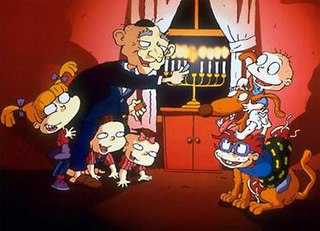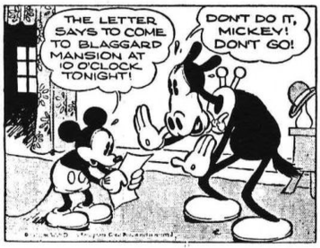Related Research Articles

A comic strip is a sequence of cartoons, arranged in interrelated panels to display brief humor or form a narrative, often serialized, with text in balloons and captions. Traditionally, throughout the 20th and into the 21st century, these have been published in newspapers and magazines, with daily horizontal strips printed in black-and-white in newspapers, while Sunday papers offered longer sequences in special color comics sections. With the advent of the internet, online comic strips began to appear as webcomics.

Garfield is an American comic strip created by Jim Davis. Originally published locally as Jon in 1976, then in nationwide syndication from 1978, it chronicles the life of the title character Garfield the cat, Odie the dog, and their owner Jon Arbuckle. As of 2013, it was syndicated in roughly 2,580 newspapers and journals and held the Guinness World Record for being the world's most widely syndicated comic strip.

Prince Valiant in the Days of King Arthur, often simply called Prince Valiant, is an American comic strip created by Hal Foster in 1937. It is an epic adventure that has told a continuous story during its entire history, and the full stretch of that story now totals more than 4000 Sunday strips. The strip appears weekly in more than 300 American newspapers, according to its distributor, King Features Syndicate.

Rugrats is an American animated television series created by Arlene Klasky, Gábor Csupó, and Paul Germain for Nickelodeon. The series focuses on a group of toddlers, most prominently Tommy, Chuckie, Phil, and Lil, and their day-to-day lives, usually involving life experiences that become much greater adventures in the imaginations of the main characters.
Klasky-Csupo, Inc. is an American animation studio located in Los Angeles, California. It was founded in 1982 by producer Arlene Klasky and her then-husband, Hungarian animator Gábor Csupó in a spare room of their apartment and grew to 550 artists, creative workers and staff in an animation facility in Hollywood.

King Features Syndicate, Inc. is an American content distribution and animation studio, consumer product licensing and print syndication company owned by Hearst Communications that distributes about 150 comic strips, newspaper columns, editorial cartoons, puzzles, and games to nearly 5,000 newspapers worldwide. King Features Syndicate also produces intellectual properties, develops new content and franchises, like The Cuphead Show!, which it produced with Netflix, and licenses its classic characters and properties.

William Morgan DeBeck, better known as Billy DeBeck, was an American cartoonist. He is most famous as the creator of the comic strip Barney Google, later retitled Barney Google and Snuffy Smith. The strip was especially popular in the 1920s and 1930s, and featured a number of well-known characters, including the title character, Bunky, Snuffy Smith, and Spark Plug the race horse. Spark Plug was a merchandising phenomenon, and has been called the Snoopy of the 1920s.

Wash Tubbs is an American daily comic strip created by Roy Crane that ran from April 14, 1924 to 1949, when it merged into Crane's related Sunday page, Captain Easy. Crane left both strips in 1943 to begin Buz Sawyer, but a series of assistants, beginning with Leslie Turner, kept the combined Captain Easy daily and Sunday strips going until October 1, 1988.
A daily strip is a newspaper comic strip format, appearing on weekdays, Monday through Saturday, as contrasted with a Sunday strip, which typically only appears on Sundays. They typically are smaller, 3–4 grids compared to the full page Sunday strip and are black and white.

Nick Magazine is a defunct American children's magazine inspired by the children's television network Nickelodeon. Its first incarnation appeared in 1990 and was distributed at participating Pizza Hut restaurants; the version of the magazine only saw two issues. The magazine returned in Summer 1993 with all types of content, primarily humor and comics. Originally published on a quarterly basis, it switched to bi-monthly with the February/March 1994 issue. It then went to ten times per year starting in March 1995, with a bi-annual December/January and June/July issue until its end in 2009.

The World's Greatest Superheroes was a syndicated newspaper comic strip featuring DC Comics characters which ran Sunday and daily from April 3, 1978, to February 10, 1985. It was syndicated by the Chicago Tribune/New York News Syndicate.
Sky Masters of the Space Force was an American syndicated newspaper comic strip created on September 8, 1958, by writer/penciler Jack Kirby and writer Dave Wood, featuring the adventures of an American astronaut. The strip stars the titular Major Skylar Masters—an American astronaut—and features his adventures in a fictionalized Space Race, including rocket launches, space stations, Moon landings, and double agents.
Planet of the Apes comics are tie-ins to the Planet of the Apes media franchise. They have been released by several publishers over the years and include tie-ins and spin-offs.
Working Daze is a comic strip written by John Zakour and illustrated by a series of artists that centers around the working relationships of a group of mostly geeks who work for MMM, a D list giant, impersonal software/tech company.
Mike Collins is an English comic book artist and writer and has been working in comics since the mid-1980s.
The Amazing Spider-Man is a daily comic strip featuring the character Spider-Man which has been syndicated for more than 40 years. It is a dramatic, soap opera-style strip with story arcs which typically run for 8 to 12 weeks. While the strip uses many of the same characters as the Spider-Man comic book, the storylines are nearly all originals and do not share the same continuity. A consistently popular strip, new material was published from 1977 to 2019, with the strip going into reruns afterwards.

"A Rugrats Chanukah" is the first episode of the fourth season of the American animated television series Rugrats. It first aired on Nickelodeon in the United States on December 4, 1996. The special tells the story of the Jewish holiday Chanukah through the eyes of the Rugrats, who imagine themselves as the main characters. Meanwhile, Grandpa Boris and his long-time rival, Shlomo, feud over who will play the lead in the local synagogue's Chanukah play. While many American children's television programs have Christmas specials, "A Rugrats Chanukah" is one of the first Chanukah specials of an American children's television series.
The animated television series Rugrats has been noted for its portrayal of Judaism, a dynamic rarely represented in American animated programming during the series' broadcast run (1991–2004). Six episodes of the series are devoted to Jewish holidays and to explaining their history, and the Pickles family is shown to be part-Jewish.
Comics has developed specialized terminology. Several attempts have been made to formalize and define the terminology of comics by authors such as Will Eisner, Scott McCloud, R. C. Harvey and Dylan Horrocks. Much of the terminology in English is under dispute, so this page will list and describe the most common terms used in comics.

Mickey Mouse is an American newspaper comic strip by the Walt Disney Company featuring Mickey Mouse and is the first published example of Disney comics. The strip debuted on January 13, 1930, and ran until July 29, 1995. It was syndicated by King Features Syndicate until 1990, when Disney switched to Creators Syndicate, which distributed the strip until 2014.
References
- ↑ "Rugrats Items in Michigan State University Library's Comic Art Collection", Michigan State University, 2000, accessed 2010-11-13.
- ↑ Holtz, Allan (2012). American Newspaper Comics: An Encyclopedic Reference Guide. Ann Arbor: The University of Michigan Press. p. 337. ISBN 9780472117567.